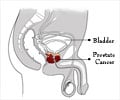Body immune system can use a simple molecule to identify prostate tumors. The research conducted in mice indicated that the molecule comes from a common protein found in all cells.
It seems that the body immune system can use a simple molecule to identify prostate tumors. The research conducted in mice indicated that the molecule comes from a common protein found in all cells. However the body is able to recognize it only if it is found on the cell surface.
Understanding how this protein, known as histone H4, signals the immune system to respond to malignant cells may help researchers refine immunotherapy strategies that harness the body's own immune system to fight tumors. Some types of immunotherapy are already being tested in patients, but many questions remain unanswered. In particular, researchers want to know if tumor cells display molecular signposts that tell the immune system, “I'm a cancer cell, destroy me.”Howard Hughes Medical Institute investigator James P. Allison and his team report finding one such signpost in prostate tumors in mice. The finding points toward possible improvements in immunotherapy.
“We know very little about how the immune system responds to tumors, especially early tumors,” said Allison, director of the Ludwig Center for Cancer Immunotherapy at Memorial Sloan-Kettering Cancer Center in New York. “Is the tumor at that stage invisible, or can immune cells detect it? And if they can detect it, can they mount a response? Those are the two big questions.”
Allison's research, published in the January 11, 2008, issue of Science, found that immune cells can, in fact, detect prostate cancer, at least in lab mice. However, the immune system mounts only a feeble attack against the tumor.
But the signpost Allison's team identified might make revving up that feeble response much easier.
The strategy relies on a specific type of immune system cell called a killer T cell. Each of these cells bristles with thousands of receptors that recognize molecules that do not belong in the body. When a T cell recognizes a foreign molecule, it tries to destroy the cell carrying it. The T cell then replicates, making copies that also latch onto the same foreign molecule.
Advertisement
In normal tissue, the distribution of receptors found on T cells is random. That is, a batch of T cells will have a range of receptors, with none being more common than the others.
Advertisement
Savage found the overrepresented receptor in 15 of 20 mice with prostate cancer. “That told us something was going on,” said Allison. “You don't see this in normal mice.”
At this point, the team knew that the immune system of the mice was recognizing a particular signpost of malignancy. But they had no idea what the signpost was.
“The obvious question was, ‘What are these T cells seeing?’” said Allison. “And that's when the hard work started.”
The team chopped up tumor cells in a dish and mixed them with antigen presenting cells and T cells carrying the receptor they had identified. The T cells switched on, which “showed we had really gotten the right receptor,” said Allison. However, during control experiments, the team also found that nearly any type of tissue, if it was chopped up, would activate the T cells.
“This started some head scratching,” said Allison. Because if every tissue activated the T cells, it meant that the signpost was not specific to the cancer cells.
The mystery deepened when mice were engineered to produce T cells that carried only the receptor of interest. Those cells did not attack every tissue. They only attacked – albeit feebly – the prostate tumors. It was a conundrum.
Returning to their experiments in the lab dish, the team decided to focus on specific parts of the tumor cells. They soon discovered that only molecules from the nucleus activated their T cells.
“This was really a surprise, because normally, nuclear proteins don't get fed onto the cell surface,” said Allison. And in living animals, T cells only recognize molecules on the surface of other cells – they can't peer deep into the nucleus.
The team then searched for particular nuclear proteins that activated the T cells. They eventually struck on histone H4. As the wrapper that sheaths the DNA inside all cells, histones are abundant in the nucleus. The finding explained why the normal cells, when chopped up, had activated the T cells – their histones were being exposed.
The team had identified the molecular signpost that activated the T cells, but they had also landed on another big question – how do the histones rise to the surface of the tumor cells. “Every cell has a ton of histone, and we just don't know why the tumor cells put it on their surface,” said Allison.
The team is now examining the blood of patients with prostate and other cancers to see if people, like mice, carry T cells sensitive to histone. If so, “then we can take those cells out and try to activate them,” said Allison. “Those cells already recognize the tumor. If we can mobilize them, maybe it will have a therapeutic effect.”
Allison and his colleagues are also conducting studies to determine whether the presence of histone H4-reactive T cells in the blood could be used as a diagnostic marker for the early detection of prostate cancer.
Source-Eurekalert
KAR/M

![Prostate Specific Antigen [PSA] Prostate Specific Antigen [PSA]](https://www.medindia.net/images/common/patientinfo/120_100/prostate-specific-antigen.jpg)






